Header image from National Park Service.gov, Denali National Park and Preserve, Alaska
Alaska officially became the 49th state on January 3, 1959.
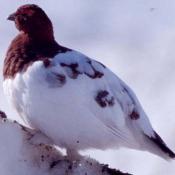 State bird: willow ptarmigan, adopted by the Territorial Legislature in 1955. It is a small (15–17 in or 380–430 mm) Arctic grouse that lives among willows and on open tundra and muskeg. In the summer the birds are largely brown, with dappled plumage, but in the winter they are white with some black feathers in their tails. Most males are monogamous, guarding both nest and mate, helping with feeding and taking over completely if the female dies.
State bird: willow ptarmigan, adopted by the Territorial Legislature in 1955. It is a small (15–17 in or 380–430 mm) Arctic grouse that lives among willows and on open tundra and muskeg. In the summer the birds are largely brown, with dappled plumage, but in the winter they are white with some black feathers in their tails. Most males are monogamous, guarding both nest and mate, helping with feeding and taking over completely if the female dies.
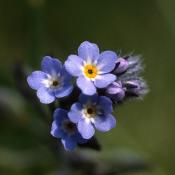 State flower: wild/native forget-me-not, Adopted by the Territorial Legislature in 1917. It is a perennial that is found throughout Alaska. From the family Myosotis from the Greek for “mouse’s ear”. The colloquial name “Forget-me-not” was calqued from the German Vergissmeinnicht and first used in English in AD 1398 through King Henry IV of England.
State flower: wild/native forget-me-not, Adopted by the Territorial Legislature in 1917. It is a perennial that is found throughout Alaska. From the family Myosotis from the Greek for “mouse’s ear”. The colloquial name “Forget-me-not” was calqued from the German Vergissmeinnicht and first used in English in AD 1398 through King Henry IV of England.
Forget-Me-Not plants symbolize true love. The forget-me-not flowers are a medium, “true blue”.
The Alzheimer’s Society uses it as an icon to raise awareness for the disease and support for caretakers.
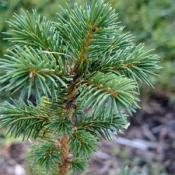 State Tree: Sitka Spruce – It is by far the largest species of spruce and the fifth-largest conifer in the world (behind giant sequoia, coast redwood, kauri, and western redcedar); and the third-tallest conifer species (after coast redwood and coast Douglas fir). Sitka spruce trees provide good roosting spots for bald eagles and peregrine falcons.
State Tree: Sitka Spruce – It is by far the largest species of spruce and the fifth-largest conifer in the world (behind giant sequoia, coast redwood, kauri, and western redcedar); and the third-tallest conifer species (after coast redwood and coast Douglas fir). Sitka spruce trees provide good roosting spots for bald eagles and peregrine falcons.
Sitka spruce is used widely in piano, harp, violin, and guitar manufacture, as its high strength-to-weight ratio and regular, knot-free rings make it an excellent conductor of sound. For these reasons, the wood is also an important material for sailboat spars, and aircraft wing spars (including flying models). The Wright brothers’ Flyer was built using Sitka spruce, as were many aircraft before World War II; during that war, aircraft such as the British Mosquito used it as a substitute for strategically important aluminium.
State Quarter
From theus50.com

The reverse of the Alaska quarter features a grizzly bear emerging from the waters clutching a salmon in its jaw. The coin’s design includes the North Star displayed above the inscription “The Great Land” and the inscriptions “Alaska” and “1959.”
The grizzly bear and salmon symbolize Alaska’s natural beauty and abundant wildlife, with the bear representing strength and the salmon representing the nutrition that provides for this strength. The grizzly flourishes in Alaska and can be observed in places such as Denali and Katmai National Parks, Kodiak Island and Admiralty Island. More than 98 percent of the United States’ grizzly population is found in Alaska.
The word Alaska comes from the Aleutian word “Alyeska,” meaning “The Great Land.” Populated by Indians, Eskimos, and Aleuts for centuries, Alaska was not explored by Europeans until 1741. Russia established a colony in Alaska to protect its lucrative fur-trading interests, but sold Alaska to the United States in 1867 for $7.2 million, or two cents per acre, when it could no longer afford to maintain the colony. Although the purchase was derided by many in the United States at the time, its worth became apparent following late 19th century gold rushes and the discovery of oil in the mid-20th century.
Capital: Juneau
Juneau, Alaska, with over 3,000 square miles (192,000 acres) within its boundaries, has the largest area of any North American city. The North Slope Borough, at 88,000 square miles (5,632,000 acres), or slightly larger than Idaho, is the largest municipally governed entity in the world. Juneau, Alaska is named for Joe Juneau, a miner and prospector who found gold in the area in 1880. (The city of Milwaukee, Wisconsin was founded by his cousin, Solomon Juneau)
Nicknames: “The Last Frontier” or “Land of the Midnight Sun” or “Seward’s Icebox”
Motto: North to the Future
Other Symbols:
Dog: Alaskan Malamute
Fish: King Salmon
Fossil: Woolly Mammoth.
Gem: Jade
Insect: Four-spot Skimmer Dragonfly
Land Mammal: Moose.
Marine Mammal: Bowhead Whale
Mineral: Gold
Song: “Alaska’s Flag”
Sport: Dog Mushing
Soil: Tanana
Alaska Facts and Trivia
The term “Alaska native” refers to Alaska’s original inhabitants including Aleut, Eskimo and Indian groups.
Alaska’s name is based on the Eskimo word Alakshak meaning great lands or peninsula.
or
The name Alaska comes from the language of the area’s indigenous people, the Aleuts (a name given to them by Russian fur traders in the mid 18th century). Natives of the Aleutian Islands referred to the Alaskan Peninsula and the mainland as alaxsxaq (ah-lock-shock), literally, “the object toward which the action of the sea is directed.”
Alaskan Inuit are commonly known as Eskimos, which comes from the French word Esquimau which, in turn, is derived from the Algonquin word askimowew, which means “eater of raw fish.
Alaska is bounded by the Beaufort Sea and the Arctic Ocean to the north; Canada’s Yukon Territory and British Columbia province to the east; the Gulf of Alaska and the Pacific Ocean to the south; the Bering Strait and the Bering Sea to the west; and the Chukchi Sea to the northwest. The narrowest distance between mainland Russia and mainland Alaska is approximately 55 miles. However, in the body of water between Alaska and Russia, known as the Bering Strait, there lies two small islands known as Big Diomede and Little Diomede. Interestingly enough, Big Diomede is owned by Russia while Little Diomede is owned by the US. The stretch of water between these two islands is only about 2.5 miles wide and actually freezes over during the winter so you could technically walk from the US to Russia on this seasonal sea ice.
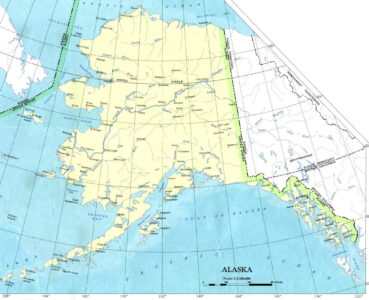
Outsiders first discovered Alaska in 1741 when Danish explorer Vitus Jonassen Bering sighted it on a voyage from Siberia.
British explorer Captain James Cook arrived in 1776 looking for the fabled Northwest Passage. He landed on the coast and made contact with the natives.
Russian whalers and fur traders on Kodiak Island established the first settlement in Alaska in 1784. They continued to settle the area, primarily in order to hunt sea otters for their fur. Over the next several years, both Spain and Britain made attempts at exploring Alaska, but the Russians continued to be the dominant European presence.
In 1867 United States Secretary of State William H. Seward offered Russia $7,200,000, or two cents per acre, for Alaska.
On October 18, 1867 Alaska officially became the property of the United States. Many Americans called the purchase “Seward’s Folly.”
On a tip from fellow prospector Robert Henderson, a sourdough [a person who has survived at least one winter in Alaska] named George Cormack and his two Indian brothers-in-law, Skookum Jim and Tagish Charlie, found gold in Alaska’s Klondike Valley at Bonanza Creek on August 17, 1896. This sparked North America’s last great gold rush.
The discovery of gold in the Yukon began a gold rush in 1898. Later gold was discovered at Nome and Fairbanks.
The area went through several administrative changes before becoming organized as a territory on May 11, 1912.
Nearly one-third of Alaska lies within the Arctic Circle.
The state’s coastline extends over 6,600 miles.
It is the largest state in the United States by area and the seventh largest subnational division in the world. Alaska is the largest state in the United States by total area at 663,268 square miles (1,717,856 km2), over twice the size of Texas, the next largest state. Alaska is larger than all but 18 sovereign countries. Counting territorial waters, Alaska is larger than the combined area of the next three largest states: Texas, California, and Montana. It is also larger than the combined area of the 22 smallest U.S. states.
The state boasts the lowest population density in the nation.
Alaska’s most important revenue source is the oil and natural gas industry.
Alaska accounts for 25% of the oil produced in the United States.
Prudhoe Bay, on the northern Alaskan coast, is North America’s largest oil field.
The Trans-Alaska Pipeline moves up to 88,000 barrels of oil per hour on its 800 mile journey to Valdez.
The fishing and seafood industry is the state’s largest private industry employer.
Most of America’s salmon, crab, halibut, and herring come from Alaska.
The Alaska Permanent Fund
The Alaska Permanent Fund is a constitutionally authorized appropriation of oil revenues, established by voters in 1976 to manage a surplus in state petroleum revenues from oil, largely in anticipation of the then recently constructed Trans-Alaska Pipeline System. The fund was originally proposed by Governor Keith Miller on the eve of the 1969 Prudhoe Bay lease sale, out of fear that the legislature would spend the entire proceeds of the sale (which amounted to $900 million) at once. It was later championed by Governor Jay Hammond and Kenai state representative Hugh Malone. It has served as an attractive political prospect ever since, diverting revenues which would normally be deposited into the general fund….
The Permanent Fund is often considered to be one of the leading examples of a “Basic Income” policy in the world.
Iditarod
Called “the Great Race of Mercy,” the Iditarod Trail experienced a surge of glory in the winter of 1925-1926 when a relay team of 20 dog mushers rushed Diphtheria serum 674 miles from Nenana, Alaska, to Nome in 127½ hours, a record at the time.
Famous bush pilot Wiley Post and humorist Will Rogers crashed and died while landing at Barrow, Alaska, in 1935. The Barrow International Airport is named today the Wiley Post-Will Rogers International Airport after the two men.
In 1943 Japan invaded the Aleutian Islands, which started the One Thousand Mile War, the first battle fought on American soil since the Civil War. This was the only part of the continental United States that was occupied during the war. The United States retook the islands after fierce fighting. It was at this point that the U.S. established a strong military presence in Alaska. A highway was also built from the state of Montana to the city of Fairbanks in Alaska, connecting the region to the lower 48 states for the first time.
In October 2014, the governor of Alaska signed a bill declaring the state’s 20 indigenous languages as official languages. Largely symbolic,
it “does not require or place a duty or responsibility on the state or a municipal government to print a document or record or conduct a meeting, assembly, or other government activity in any language other than English.”
At 20,320 feet above sea level, Mt. McKinley, located in Alaska’s interior, is the highest point in North America. (Alaska is home to 17 of the 20 highest peaks in the U. S.) In 1896, a gold prospector named it “Mount McKinley” in support of then-presidential candidate William McKinley ; that name was the official name recognized by the Federal government of the United States from 1917 until 2015. In August 2015, following the 1975 lead of the State of Alaska, the United States Department of the Interior announced the change of the official name of the mountain to Denali.
Alaska is the most popular state for flying in the U.S. One of every 58 Alaskans is a registered pilot, and one out of 59 owns an airplane. Lake Hood in Anchorage is the largest and busiest seaplane base in the world, averaging 234 landings and take-offs per day.
Alaska has roughly 5,000 earthquakes every year. In March of 1964, the strongest earthquake recorded in North America occurred in Prince William Sound with a magnitude of 9.2.
Alaska regularly supports Republicans in presidential elections and has done so since statehood. Republicans have won the state’s electoral college votes in all but one election that it has participated in (Johnson in 1964). Because of its population relative to other U.S. states, Alaska has only one member in the U.S. House of Representatives. Donald Trump carried the state in 2016 by 51.8% of the vote; Hillary Clinton had 36.5%; Libertarian Gary Johnson received almost 6%.
Strange laws:
It is illegal to whisper in someone’s ear while they are moose hunting.
While it is legal to shoot bears, waking a sleeping bear for the purpose of taking a photograph is prohibited.
Who doesn’t love a good toot on a vuvuzela? Well guess what, if you’re in Fairbanks, Alaska, don’t even think about it! It’s illegal to blow a horn in a manner that disrupts the peace
For the final and perhaps strangest of these wacky laws, it is considered an offense to push a live moose out of a moving airplane.
People:
-
- Tony Barnette, baseball player
- Margaret Elizabeth Bell, author
- Benny Benson, designed state flag at age 13
- William A. Egan, first state governor
- Ray Mala, actor
 Sarah Palin, governor, v-p nominee
Sarah Palin, governor, v-p nominee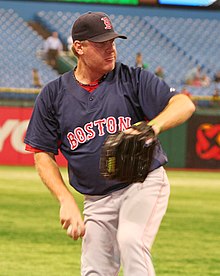 Curt Schilling, baseball pitcher
Curt Schilling, baseball pitcher
Music:
Alaska’s flag (state song)
North to Alaska by Johnny Horton
When it’s Springtime in Alaska by Johnny Horton
American Child by John Denver
To the Wild Country by John Denver
Alaska and Me by John Denver
The Alaskan Song (Under The Midnight Sun) by Lacy J. Dalton
Home To Alaska by Lee Greenwood
Road To Alaska by The Bee Gees
I’ll See Alaska by Black Irish Band
Alaska Bloodline by Joe & BingCredits:
See 50 states.com
See ducksters.com
See Wikipedia
See Only In Your State.com
See Fact Retriever.com
See History.com
See Mental Floss.com
See playlistresearch.comSee Tidbits of History.com/states for interesting facts and trivia about more of these United States.

Pingback: This day in history, January 3